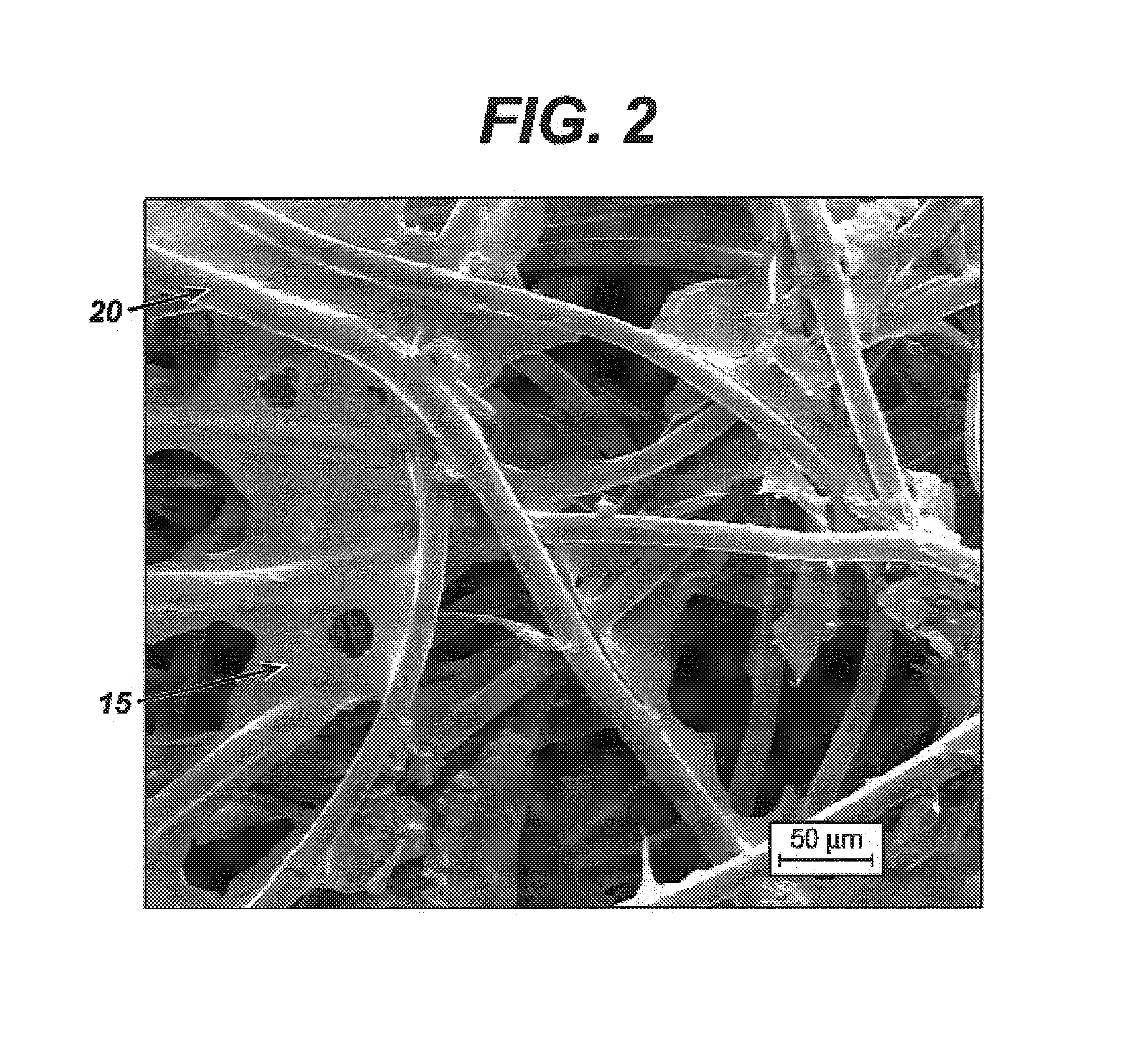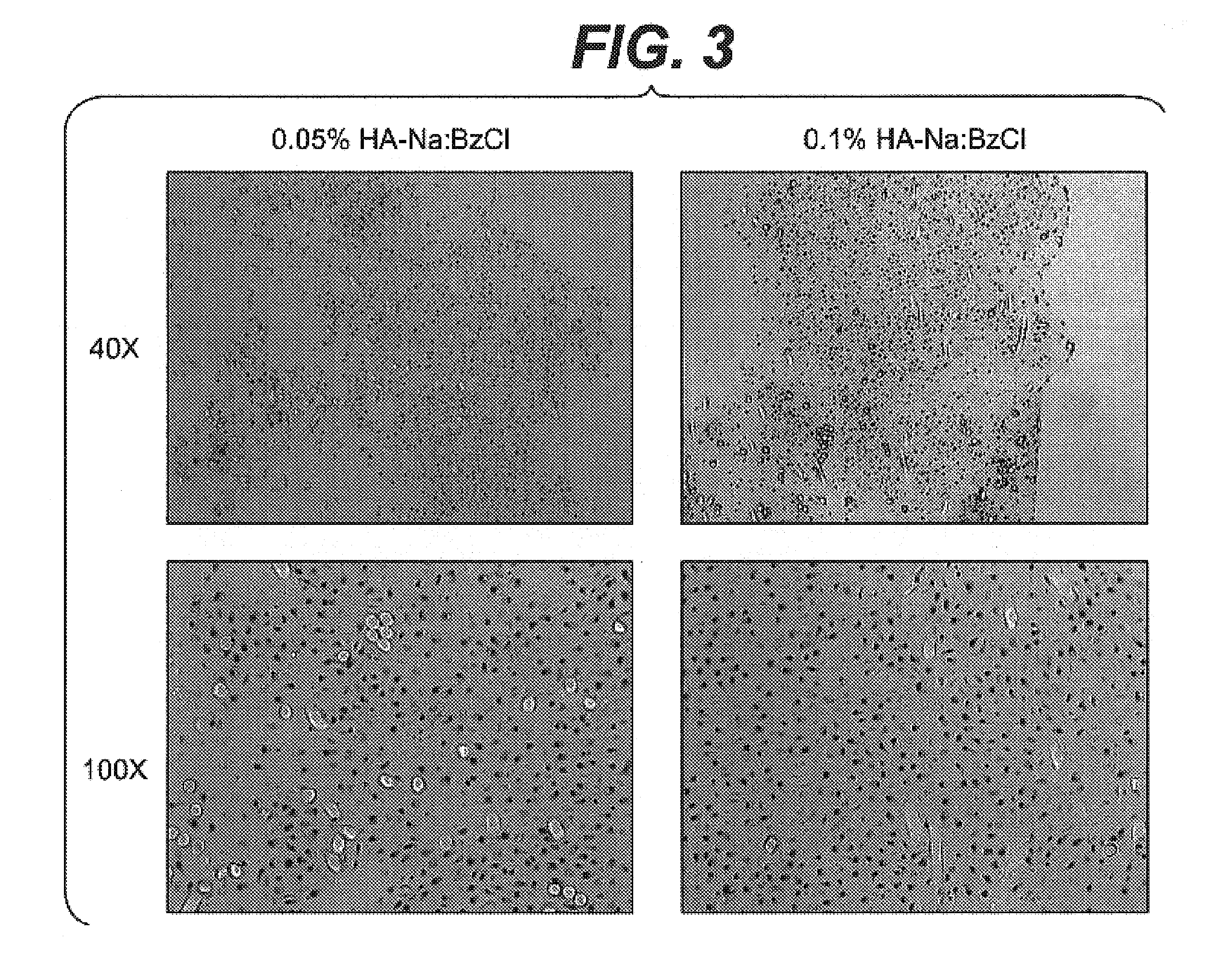Modified hyaluronic acid for use in musculoskeletal tissue repair
a technology of musculoskeletal tissue and hyaluronic acid, which is applied in the field of modified hyal, can solve the problems of limiting its use to applications, affecting the stability of musculoskeletal tissue, and unable to meet the needs of tissue scaffolds that must maintain structural integrity for extended periods of time, and achieves the effect of reducing the number of hyaluronic acid toxicity and reducing the risk of toxicity
- Summary
- Abstract
- Description
- Claims
- Application Information
AI Technical Summary
Benefits of technology
Problems solved by technology
Method used
Image
Examples
example 1
[0047]This example describes several procedures used to make HA-BzCl complexes.
[0048]Equimolar amounts of sodium hyaluronate (1.5 gm) and benzalconium chloride (1.3 gm) were mixed together in distilled water. After 1 hour of stirring at 25° C., the precipitated solid was filtered and vacuum dried overnight, yielding 1:1 molar HA-BzCl complex.
[0049]In a similar manner, 2:1 and 4:1 molar HA-BzCl complexes were made, except the amount of benzalconium chloride was changed from (1.3 gm) for the 1:1 molar HA-BzCl complex, to 0.65 gm and 0.33 gm of benzalconium chloride for the 2:1 and 4:1 molar HA-BzCl complexes, respectively.
[0050]An alternate procedure to form 1:1 HA-BzCl complex was also used. Sodium hyaluronate (1.5 gm) was added to a solution containing benzalconium chloride (1.3 gm) in a mixture of 1,4-dioxane (118 gm) and water (78.5 gm). The solution was stirred for 24 hours at 25° C. and centrifuged for 1 hour at a rate of 4,000 rpm using an Eppendorf Centrifuge 5810R. Residual N...
example 2
[0051]This example describes the stability of the HA-BzCl complex fabricated according to Example 1, in distilled water or aqueous buffer solution.
[0052]First, 250 milligrams of 1:1 HA-BzCl complex made in Example 1 was suspended in 20 grams of distilled water and stirred for 2 weeks at 25° C. The remaining solid was vacuum dried at 40° C. for 48 hours using phosphorous pentoxide drying agent to yield 55 milligram of a white solid. This represents a 78 percent loss of the starting mass of 1:1 HA-BzCl complex.
[0053]In a second experiment, 72 milligrams of 1:1, 2:1, and 4:1 HA-BzCl complex made in Example 1 were each suspended in PBS solution (pH 7.4, 37° C.) and shaken in a constant temperature water bath. The degradation of the HA-BzCl was monitored by measuring the absorbance peaks corresponding to HA and BzCl at 205 nm and 262 nm, respectively, using a UV / Vis spectrometer. Calibration curves were generated using pure HA and BzCl dissolved in PBS. The results indicated that 100 per...
example 3
[0054]This example describes the process of incorporating the HA-BzCl complex described in Example 1 into a porous, foam substrate prepared from a hydrophobic polymer. The foam substrate was prepared utilizing a copolymer of 65 / 35 PGA / PCL produced by Birmingham Polymers Inc. (Birmingham, Ala.) with an I.V. of 1.79 dL / g, as measured in HFIP at 30° C. The foam was fabricated using a lyophilization procedure as described herein.
[0055]A solution of 0.1 weight percent of HA-BzCl solution in a 60 / 40 1,4-dioxane / water mixture was prepared.
[0056]A laboratory scale lyophilizer (Model Duradry, from FTS Kinetics, Stone Ridge, N.Y.), was used in this example. The synthetic foam substrate (70 mm×70 mm×2 mm) composed of 65 / 35 PGA / PCL was placed in a 4-inch×4-inch aluminum mold. The HA-BzCl polymer solution was added to the mold such that the solution covered the foam substrate such that the substrate was submersed in the solution.
[0057]The mold assembly then was placed on the shelf of the lyophil...
PUM
| Property | Measurement | Unit |
|---|---|---|
| molecular weight | aaaaa | aaaaa |
| dielectric constants | aaaaa | aaaaa |
| dielectric constants | aaaaa | aaaaa |
Abstract
Description
Claims
Application Information
 Login to View More
Login to View More - R&D
- Intellectual Property
- Life Sciences
- Materials
- Tech Scout
- Unparalleled Data Quality
- Higher Quality Content
- 60% Fewer Hallucinations
Browse by: Latest US Patents, China's latest patents, Technical Efficacy Thesaurus, Application Domain, Technology Topic, Popular Technical Reports.
© 2025 PatSnap. All rights reserved.Legal|Privacy policy|Modern Slavery Act Transparency Statement|Sitemap|About US| Contact US: help@patsnap.com



